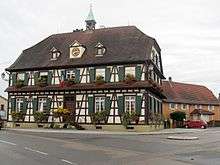Gambsheim
| Gambsheim Gàmbse | ||
|---|---|---|
| ||
 Gambsheim | ||
|
Location within Grand Est region  Gambsheim | ||
| Coordinates: 48°41′35″N 7°53′03″E / 48.6931°N 7.8842°ECoordinates: 48°41′35″N 7°53′03″E / 48.6931°N 7.8842°E | ||
| Country | France | |
| Region | Grand Est | |
| Department | Bas-Rhin | |
| Arrondissement | Haguenau-Wissembourg | |
| Canton | Brumath | |
| Government | ||
| • Mayor (2001–2008) | Hubert Hoffmann | |
| Area1 | 17.38 km2 (6.71 sq mi) | |
| Population (2006)2 | 4,352 | |
| • Density | 250/km2 (650/sq mi) | |
| Time zone | CET (UTC+1) | |
| • Summer (DST) | CEST (UTC+2) | |
| INSEE/Postal code | 67151 / 67760 | |
| Elevation | 126–131 m (413–430 ft) | |
|
1 French Land Register data, which excludes lakes, ponds, glaciers > 1 km² (0.386 sq mi or 247 acres) and river estuaries. 2 Population without double counting: residents of multiple communes (e.g., students and military personnel) only counted once. | ||

Gambsheim is a commune in the Bas-Rhin department in Grand Est in north-eastern France.
Geography
It is adjacent to a river crossing into Germany that is favoured by southbound autoroute traffic wishing to avoid traffic delays around Strasbourg. The road crossing the river coincides with a large lock which is also the site of one of the Rhine's first fish ladders installed to support migratory fish in general and, more specifically, to try and restore the abundant salmon population for which the upper Rhine was famous before the early 20th century, when the installation of a series of locks rendered the river navigable beyond Basel for boats, but blocked it for migrating fish.
Landmarks
- The church of St Nazaire.
- Gambsheim lock gates (Upper Rhine).
- Town hall, built in 1823 to replace an 18th-century building.[1]
- Gambsheim hydroelectrical power plant; established in 1967, it produces 141 MW.
See also
References
- ↑ Patrimoine - La mairie;
External links
| Wikimedia Commons has media related to Gambsheim. |
.svg.png)